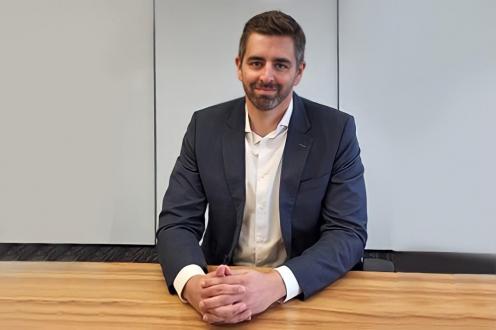Accenture’s APAC Lead for Wealth Management on Driving Digitisation and Strategy to Deliver Enhanced Client Engagement

Jun 1, 2022
The Hubbis Digital Dialogue of May 12th saw a panel of experts drill down into how today’s essential and increasingly user-friendly digital tools and solutions can combine ideally with the ‘softer’ elements of wealth management to deliver genuinely positive, relevant impact to private clients. In doing so, the private banks and EAMs will be well on the path to differentiating themselves and further building their brands and their platforms for the years ahead. David Wilson, APAC Wealth Management Lead for Accenture, was one of the experts and we have distilled some of his insights in this short report.
Accenture is at the cutting edge of wealth management transformation globally. On its website, the firm points out that no industry can escape digital's disruptive effect, especially not wealth management, adding that today’s clients expect a whole new kind of experience that’s more informed, more personalised, more transparent; and they want it more quickly than ever before.
Firms that rise to the digital challenge capitalise on industry insights, transform their businesses from front to back and strive for operational excellence, Accenture’s experts observe, and state that globally, they leverage their deep industry experience and their very broad range of capabilities and synergies across their entire business to deliver end-to-end solutions for leading wealth management firms.
Wilson himself is leading the firm’s charge in APAC and is clearly deeply committed to delivering Accenture’s expertise on the ongoing digitisation of the Asian wealth management industry. His insights during the panel discussion, therefore, offer an insider’s perspective on the state of play.
He first offered some broad-brush strokes to paint a picture of client engagement from a digital perspective. “What is digital client engagement and the digital client experience?” he pondered.
“The engagement and experience imply empathy, so you know the client, and you can anticipate what the client wants. The experience should be pain-free, it should reduce friction, require fewer steps, and be as smooth as possible. Then digitally, the channels you need must all be available, and need to perform at the required level and have all the functionalities incorporated.”
He observed that a lot of the cutting-edge progress is being made away from the financial sector and can be applied to the world of wealth management, at least where regulation permits. The hospitality sector, for example, is achieving a lot around transparency of pricing and product discovery. The purchasing journey is very easy and triggers the experience element, for example, automated emails to thank the client for choosing that hotel or institution. The triggering then might ask for more information that will be applied to making the experience of the actual hotel more impactful on arrival.
In the luxury sector, which is more directly relevant to the private banking sector, there is with top hotels a strong drive to know the client and then personalise their experience. “For example,” he said, “what kind of mattress do they like, what type of view or room, and so forth”, often enabled by a systematic use of data to better anticipate and replicate positive experiences.
A heavily regulated industry is the medical sector, where the pandemic has greatly accelerated e-diagnosis, e-consultation, appointment making, and so forth. “And we see in the US that there is more machine learning, where they can actually automate through data and analytics, the diagnosis, and the doctor then has more time to focus on the key issues,” Wilson commented. “Many of these advances can be applied to private banking.”
As to the precise digital journey offered to customers, that will depend significantly on the types of clients, whether mass affluent or extremely wealthy, Wilson commented.
“For example,” he said, “if you want to attract young, affluent or future-affluent customers, you can offer digital-only for digital natives in the young demographics of Southeast Asia, to start those customers on their wealth management journey. But you do not need to throw out the RM assisted journey; that will still be there in parallel, but that can be more for wealthier clients, or those we already know will pay more for a higher-touch model. The RMs are thereby somewhat freed up to serve the more complex needs. And you stitch all this together in the north star of seamless omni-channel and then personalise accordingly to the particular clients across the steps of the journey.”
Expanding on the topic of personalisation, he said there are two elements. There is the personalisation of the conversation and the personalisation of actions or recommendations.
“The conversation centres on understanding the clients, their expectations, their timings, their frequency, their preferred channels, so you become more than advisor; you've suddenly got more mindshare,” he explained. “This is important as clients in Asia are multi-banked, especially in private banking at the higher levels, so you want to be considered the primary wealth manager where we know you get hold of a lot more of the AUM. So, personalising the conversation is key.”
Then for the actions and recommendations, Wilson explained that you are acting on anticipating of what a customer may be interested in or perhaps needs to do. For example, they might want to take a new investment route or perhaps they urgently need some portfolio rebalancing. They might be looking like they want to leave the bank, so you can react by perhaps changing the RM, adapting fees, and so forth. “You can also pull out all the different levers within the bank, so the client gets a more 360-degree offering from all areas,” he elucidated.
Wilson’s last observation of the discussion centred on CRM. He explained that banks do not want to apply CRM just for the sake of CRM. They need to make it entirely relevant to the RMs and advisors as they try to solve for advisory, execution, client servicing, and improve all of the internal practice management around sales planning.
“If you have gone down the CRM route,” he elaborated, “you've got to make that work with all your internal systems and processes and strategies and teams to make sure that the life of an RM is not 80% admin. The RMs and advisors need to be delivering added value, delivering on their relationships, and further building trust. When the RMs see the opportunity of some major activity with their clients, they must actually have the time to focus and deliver.”
Accordingly, he explained, that is why there is a lot of momentum in the industry around trying to give RMs the cockpits and the tools so that they can be empowered and enabled, so they have a 360-degree client perspective, and so they can forge ahead easily with next best actions, next best conversations, portfolio rebalancing, and so forth. And that will result in a far more personalised, relevant and trust-engendering relationship and activity between the bank and the client.

Principal Director, Asia Wealth Management Lead at Accenture
More from David Wilson, Accenture
Latest Articles






